#Kanda-Myojin Jinja
Text


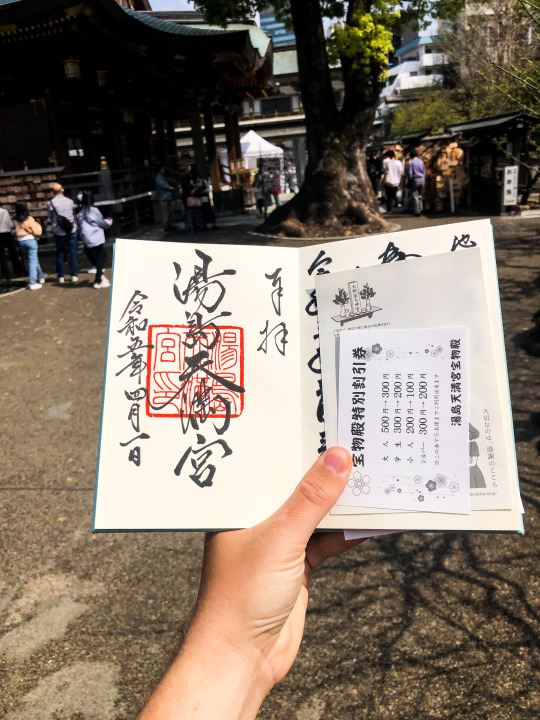


Szóval ma megint kifejezetten szentélylátogató napot tartottam. Az első hely a Yushima Tenmangu szentély volt, ahol több másik szentélyhez hasonlóan ahol már Oszakában és Kiotóban is jártam, Sugawara no Michizane (Tenjin) Kamija lakik. A szentély leginkább a diákok körében népszerű, akik sikeres vizsgákért szoktak itt imádkozni. Itt egész sokan voltak ezen a szép szombat délelőttön, de meglepő módon magamon kívül kizárólag csak japánokat láttam. Egy nagyon szép, rendezett szentély, gyönyörű parkkal és a világ legjóságosabb arcú bikaszobrával. A Sugawara no Michizane-nek szentelt szentélyekben egyébként azért találhatók meg a bikaszobrok, mert a legenda szerint a költőt halála után egy ökrösszekér húzta a hintót. A bika azonban egy helyen hirtelen megállt, és nem volt hajlandó továbbmenni. Sugawara no Michizane-t később ezen a helyen, Fukoukában temették el, ahol később a Dazaifu Tenmangu szentélyt emelték.
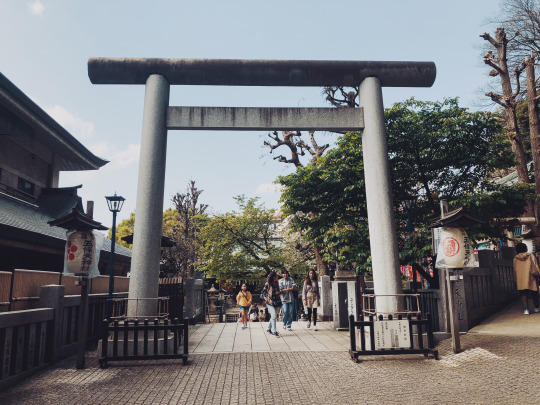
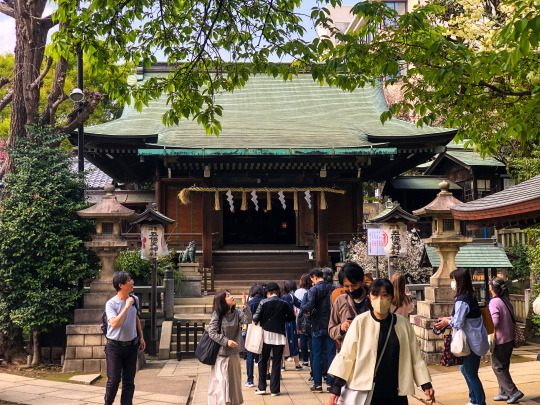

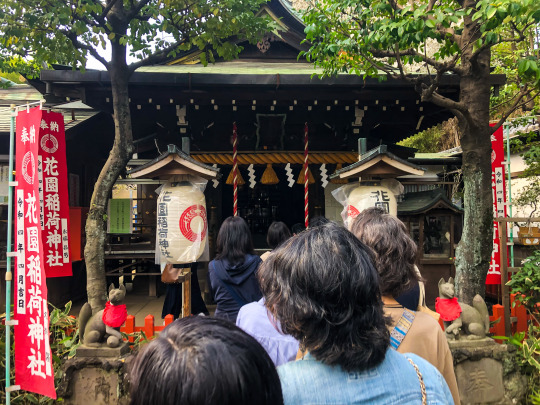
A következő két szentély a Gojoten Jinja és a Hanazono Inari Jinja volt, amelyek gyakorlatilag egy területen találhatók az Ueno Parkban. A Gojoten Jinja három Kamija Okuninushi, Sukunabikona, és Sugawara no Michizane, itt tehát főként betegségekből való felgyógyulásért és sikeres vizsgákért imádkoznak a látogatók. A Hanazono Inari Jinja pedig egy gyönyör kis Inari szentély, sok karmazsinvörös toriival. Mindkét szentély nagyon kellemes és nyugodt hangulatú, a sok turista ellenére is. Így a cseresznyevirágzás idején pedig különösen gyönyörűek.
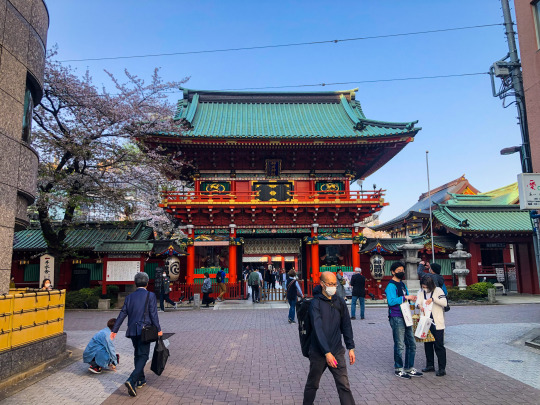
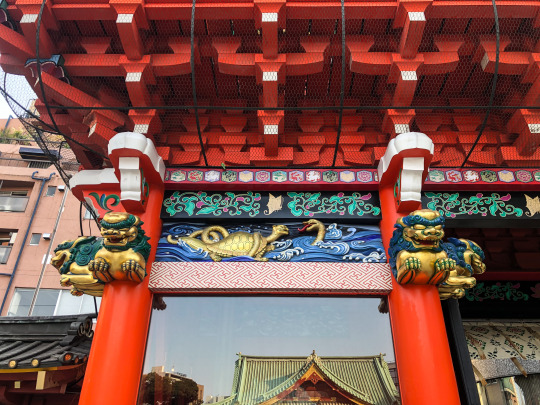




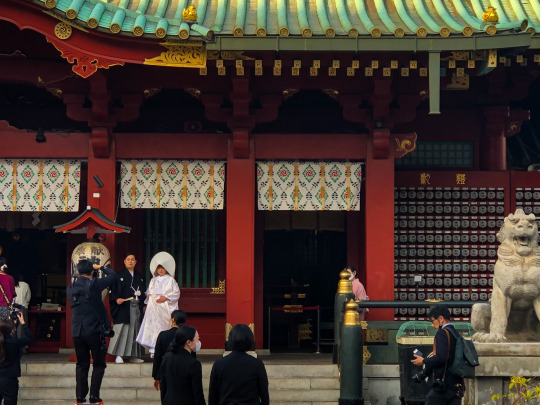

Végül pedig a Kanda-Myojin szentélyban voltam, ami egy minden szempontból lenyűgöző hely. Egyrészt építészetileg, másrészt az 1300 éves múltja miatt, végül pedig azért, mert itt láttam először omamori automatát. Ez a szentély egyébként arról is híres, hogy mivel a tech-világ egyik középpontjában, Akihabarában található, így akár az elektronikai cikkeink védelme érdekébe is vásárolhatunk itt omamorit.
Egyébként édesanyám gyakran mondogatta nekem fiatalkoromban, hogy "hülye vagy, fiam", amit egy ideje nem mondott, mert szerintem azt hiszi, hogy így 30 felett már nem vagyok annyira hülye, de hát az a helyzet, hogy hazafelé betévedtem egy bolhapiacra az Ueno Parkban, ahol a napi (vagy inkább a heti) büdzsém maradékát két dologra verhettem el: az egyik egy Yamato Transport kisautó, a másik pedig az olcsó kimonóárus portékája volt. Szóval hát az a helyzet, hogy kicsit fáj a szívem a kisautó miatt, de belegondoltam, hogy csak 35 éves leszek idén, úgyhogy hirtelen felindulásból vettem egy haorit, ami amúgy szerintem kurva jól néz ki, de így igazából ötletem nincs, hogy mikor és hová tudnám én ezt felvenni, pláne, hogy egy rendes kimono szetthez most akkor minimum egy olcsó nagagit is szereznem kellene obival meg ilyenekkel. DE amúgy annyira kényelmes anyaga van, hogy beszarsz.

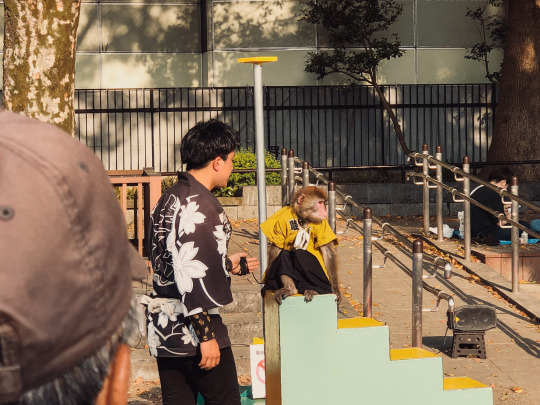
Igen, persze, nyilván tudom, hogy nem így kell hordani, csak úgy felkaptam mutatóba a pólóra és a mackóalsóra, kövezzetek meg. Mazsom-san sokkal elegánsabb nálam.
Ja, amúgy ez a tízezredik posztom.
#Japán#Tokió#goshuin#Yushima Tenmangu Jinja#Gojoten Jinja#Hanazono Inari Jinja#Kanda-Myojin Jinja#gpoy
19 notes
·
View notes
Photo
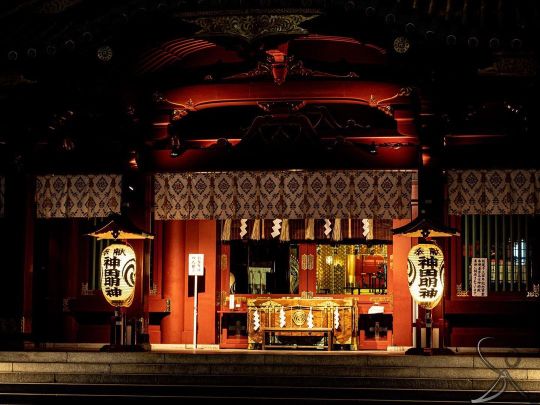
Kanda Myojin Shrine, Akihabara 神田明神 #akihabara #jinja #tera #temple #japan #kanda #shrine #myojin #tokyo #traditional #history #神田明神 #秋葉原 #東京 #伝統 #神社 #お寺 #寺 #夜 #япония #традиции #акиба #токио #храм (at Akihabara, Tokyo) https://www.instagram.com/p/Cne68XJhtjy/?igshid=NGJjMDIxMWI=
#akihabara#jinja#tera#temple#japan#kanda#shrine#myojin#tokyo#traditional#history#神田明神#秋葉原#東京#伝統#神社#お寺#寺#夜#япония#традиции#акиба#токио#храм
21 notes
·
View notes
Text
when you wanna describe ur headcanons for how susano-o and tsukuyomi looked before their current smtv forms and then ur like. i know. i'll just write a fic from okuninushi's pov. and here we are.
this muse possessed me
-
In the liminal space that existed between midnight and the first hour of the new day, the gods enjoyed scant moments of peace where they slipped from human consciousness and could revel as they pleased until they decided to be observed by the linear flow of time once more. This was when feasts were thrown, or parties celebrating this or that, and with Japan so prosperous, the Kunitsukami of course took that as an excuse to make merry often.
(Granted the driving force of this was Susano-o himself, technically one of the Amatsukami once more but the unofficial leader of the Kunitsukami - when he wasn’t busy butting heads with the stern and domineering Masakado who was also an unofficial leader- while Okuninushi was officially- never mind. The leadership hierarchy in the Kunitsukami was not as clear cut as it was amongst the Amatsukami, let’s leave it at that)
On this particular night it was pleasantly cool, autumn soothing the sticky summer heat and bringing with it a revitalising freshness that stirred the gods from their overheated lethargy. While several of his kin had gambolled over to Asakusa-jinja shrine, Okuninushi remained at Kanda Myojin shrine at Susano-o’s request.
‘A quiet night of revelry’, Susano-o had asked, and Okuninushi had been so baffled by such an uncharacteristic request that he had agreed from concern alone. Susano-o was anything but quiet, and his method of revelry even less so! Perhaps Bethel’s ever cracking whip was beginning to exhaust even Susano-o’s vast stamina, and Okuninushi, ever willing to lend a healing hand to comrades and kin, was determined to give what succour he could.
So, during that liminal space between midnight and the first hour of the new day, where Amaterasu closed her eyes and Tsukuyomi opened his, Okuninushi had prepared a quiet space for them on the shrine grounds - absent of humans, who did not exist in this space during this time. The sky was dark, the light pollution concealing the stars and the moon hidden in shadow, Susano-o’s arrival was easy to sense - a gust of cool wind carrying the scent of ozone and fresh rain - but his companion…
His companion?
Okuninushi couldn’t quite grasp the second presence accompanying Susano-o, so wan and smudged around the edges they easily faded beneath Susano-o’s far brighter and wilder brilliance. His confusion didn’t last long, however, as when Susano-o trudged into view, so too did his companion - and everything made sense.
Susano-o looked as hale and heart as ever: his long, dark blue hair was tied back into a ponytail, adorned with a comb that Kushinada had given him centuries ago. Though their love had evolved into something more platonic in recent decades, it was still love and still passionate, and Susano-o was ever the sappy romantic beneath his booming voice and hunger for excitement. The more striking thing was that Susano-o had actually covered up his chest - er, somewhat. The thin yukata he wore, pattern with sea-foam and more suited for summer than the cool autumn, was loosely tied around the waist, the yukata sagging open and flashing more than enough of his chest to make it seem more obscene than simply walking around topless.
But that was how Susano-o was, wild and free and lascivious. He oozed confidence and never affected humility over his handsome looks and desirable body, flaunting it for everyone to admire and envy. His broad frame and towering height made it difficult to ignore as well, yet after so many centuries Okuninushi just felt fond and tired in equal measure. Susano-o will Susano-o, as Masakado had once muttered in his cups.
Yet, if Susano-o was a towering monument to gorgeous masculinity, his companion was the complete opposite. Shorter, more lithe, and walking half a step behind Susano-o to partially be in his shadow, walked the less well-known sibling of the famous Amatsukami triplets: Tsukuyomi.
Where Susano-o was broad, Tsukuyomi was svelte, all sleek curves and graceful angles that would make Uzume frown in jealousy. Yet, it was not feminine - not masculine either. As a perfect balance to Susano-o and Amaterasu both, Tsukuyomi was so thoroughly ambiguous that if Okuninushi did not personally know the man, he would never be able to ascribe a gender to him at a glance - well, if he was human, in any case, as they were the sort to get a little funny about that.
But still, Tsukuyomi was Susano-o’s brother, so there were similarities between them: his hair was tied back in a ponytail, though there were no adornments, and his hair was a vibrant silver with a faint, pale lavender tint whenever it caught the light. Where Susano-o’s hair was thick and fighting to burst free from its tie, Tsukuyomi’s was sleek and shiny, almost fluid with how it moved. His face as well was eerily similar to Susano-o’s, but just with softer edges - softened further by the thin, sheer veil that he wore whenever he made public appearances outside of Bethel or his own shrines (of which there were few).
Okuninushi never knew why Tsukuyomi wore it. The veil never hid his face, but only made it seem slightly indistinct and hazy, but his silvery eyes were very bright - it made it easy to overlook his facial similarity to Susano-o. But perhaps that was the point…
Like Susano-o, Tsukuyomi was also in a summer yukata, but his was properly tied and in a drab colour of dark blue. Oddly enough, his gait was lethargic compared to Susano-o’s far more energetic one, merely confirming Okuninushi’s suspicions: this ‘quiet night’ was not for Susano-o, but for his brother.
Tsukuyomi was an Amatsukami, but Okuninushi had no direct quarrel with him. In fact, while Tsukuyomi was a schemer, his dedication to Tokyo was as fervent as Masakado’s. So long as they met with Susano-o as the intermediary, in the liminal space between midnight and the first hour of the day, then Okuninushi had no issue welcoming Tsukuyomi to his table for the night.
#shin megami tensei 5#smtv#smt5#tsukuyomi (smt)#susano-o (smt)#fanfic#i like writing character descriptions but the mechanism of doing it works best from an outside pov#ough#why can i not directly beam my mental images into people's brains...
17 notes
·
View notes
Text
The Origins of Torii
There are two kinds of Sandō (road that approaches the shrine), a road that comes from a town or city and continues to the shrine, and the road from the entrance of the shrine to the Haiden (Prayer Hall) • Honden (Main Hall). Both are sacred roads in which visitors walk, and mikoshi are carried along the path. Therefore in order to demarcate the sacred land, torii, koma inu, stone lanterns, etc... are placed. Koma inu, and stone lions will be discussed later on, here is where torii are being discussed.
In fact the origin of Torii is not clear. From extant examples and paintings in picture scrolls, it is known that a similar type of torii existed in the 12th century, but it is not known when and for what purpose they were built.
Why are there so many different types of Torii?
The present torii gate functions as a symbolic gateway, indicating that the area inside (beyond) the gateway is sacred ground. It also serves as a warning that any disrespectful behavior beyond the gate will result in punishment.
Another feature of torii gates is that there are many types. It is said that the shape of the torii may have indicated the type of kami, but this is not certain. The form can be broadly classified into the Shinmei type and the Myojin type. While the Shinmei type is simple, the Myojin type is highly decorative and sometimes painted in vermilion. This may be related to the fact that Myojin-style torii are often erected at shrines of common people's beliefs, as they have a strong sense of Shinto/Buddhist syncretism.

Parts of a Torii Gate
笠木 Kasagi
Cap Piece that covers the top of a Torii
島木 Shimagi
Long horizontal timber above the columns on a Torii, right below the Kasagi
台輪 Daiwa
The single piece placed where the columns meet the Shimagi, believed to prevent rot from setting in from the top of the pillars
額束 Gakutsuka
The plaque that holds the name of the shrine
楔 Kusabi
Wedges/Lynchpins
貫 Nuki
Lower horizontal timber, traditionally does not pierce the columns, and in Shinmei style torii, is said to be round
柱 Hashira
The two vertical columns leading up to the horizontal bars
藁座 Waraza
Reinforcement for the Daīshi at the bottom of the torii
台石 Daīshi
Stone pedestal at the bottom of torii
亀腹 Kamebara
White plaster bun-shaped mounds used to reinforce support base stones.
Varieties of Torii
神明系 Shinmei Style
黒木鳥居 Kurogi Torii
Made from logs where the outer bark is still attached. Seen at shrines like 野宮神社 Nonomiya Jinja.
鹿島鳥居 Kashima Torii
The lower cross bar is quadrilateral (instead of rounded), and sticks out past the pillars holding the torii up. Seen at shrines like 鹿島神宮 Kashima Jingū.
神明鳥居 Shinmei Torii
The pillars, top crossbar and lower crossbar are all rounded. See at shrines like 神明宮 Shinmeigū.
伊勢鳥居 Ise Torii
The upper crossbar is pentagonal in shape. Seen at shrines like 伊勢神宮内宮・外宮 Ise Jingū Naikū • Gekū and 熱田神宮 Atsuta Jingū

Photo Credits
1 , 2 , 3 , 4
明神系 Myojin Style
Usually these have the cap piece called a Kasagi while Shinmei do not
八幡鳥居 Hachiman Torii
The edge of the top bar is slanted. Seen at shrines like 岩清水八幡宮 Iwashimizu Hachimangū.

台輪(稲荷)鳥居 Daiwa (Inari) Torii
Below the upper crossbar are Daiwa (see above definition). Seen at shrines like 伏見稲荷大社 Fushimi Inari Taisha.

春日鳥居 Kasuga Torii
Less warping of the cap piece and upper crossbar (fairly flat). Seen at shrines like 春日大社 Kasuga Taisha.

両部鳥居 Ryōbu Torii
Has smaller support columns attached to the main pillars. Seen at shrines like 厳島神社 Itsukushima Jinja, and 氣比神宮 Kehi Jingū.

中山鳥居 Nakayama Torii
The same as a Myōjin Torii, except the lower crossbar doesn't stick out. Seen at shrines like 中山神社 Nakayama Jinja.

明神鳥居 Myōjin Torii
Both the upper and lower crossbars have warping (meaning they're more curved). Seen at shrines like 神田明神 Kanda Myōjin.
山王鳥居 Sannō Torii
Above the Kasagi, there is an extra part called the Gasshō, which is a triangular shaped piece. Seen at shrines like 日吉大社 Hiyoshi Taisha.

三輪鳥居 Miwa Torii
To the sides are smaller support torii. Seen at shrines like 大神神社 Ōmiwa Jinja.

Photo Credit
1 , 2 , 3 , 4 , 5 , 6 , 7 , 8
Translations from 参拝したくなる! 日本の神様と神社の教科書 by 渋谷申博

3 notes
·
View notes
Text


praying for good luck with the turnips this week ✨
#I’ve always really wanted to do a shrine on my island !!#I’m really happy with the way this turned out#hopefully it does the real thing some justice#loosely based on multiple shrines in Tokyo#but mostly asakusa-jinja#and kanda myojin shrine#and the zenkoku-ji temple in kagurazaka#my post#acnh#furubaycrossing#animal crossing#animal crossing new horizons#new horizons#acnh community#acnh screenshots#acnh screencap#acnh scenery
509 notes
·
View notes
Photo



神田神社(神田明神)
https://www.sa-ka-ki.com/jinja/tokyo/kanda/
#神田神社#神田明神#獅子山#狛犬#隋神門#千代田区#神田#日本#神社#神道#kanda shrine#kanda jinja#kanda myojin#komainu#東京#tokyo#kanda#Japan#jinja#shrine#shinto#gate
50 notes
·
View notes
Note
SPOILER
omg i actually thought abt sending this earlier bc this may be as well me stretching it by miles but,,, the leaks got me thinking, what if yuta went to africa, not for training, but to research on how to get rika back. miguel must have used that as a leverage since cursed user shld be executed on sight after shinjuku. i quoted from here : Shamanism is a healing tool and has one fundamental difference from other alternative or holistic methods, that I have experienced – that is, to heal or to bring to wholeness is undertaken with the help of our Spiritual Guides, Helping Spirits, Ancestral Helping Guides or Divine Beings with a focus on establishing what is the root cause of a problem or issue. As we acknowledge this we are able to release and heal – to become whole. And another is our Helping Spirits or Guides sole concern is our growth and change as their mission. And this is done with unconditional love.
“unconditional love”, yuta did said “pure love” in vol 0, uhhhh...i did went on a random guess on the 3 onryos but since rika can be considered as one, so, yuta travelled all the way to africa to convert her to goryo?
and additional info since akutami is actually (?) touching on the onryos-goryos topic, there is a shrine called “kami-goryo-jinja shrine (上御霊神社)”, located in kamigyo ward, kyoto. 8 figures are enshrined there, the hassho goryo, including sugawara no michizane. all those 8 onryos lost their lives in a political struggle against the imperial court.
while the 3 onryos (vengeful spirits) : sugawara no michizane, at dazaifu tenmangu shrine (fukuoka prefecture) & kitano tenmangu shrine (kamigyo ward, kyoto), taira no masakado at tsukudo-jinja shrine & kanda myojin shrine (both in chiyoda ward, tokyo) and emperor sutoku at shiramine-jingu shrine (kamigyo ward, kyoto)
is this an modern version of the shoguns-imperial relation in jjk-verse, where the former holds the actual power and the latter is just for a show.....shamans elders/ world and the govt(?) [of every countries], in the case of jpn, the fujiwaras was holding the power. wtf exactly happened in pre-heian/ kofun to meji era in jjk 😭 -🐱
❗️❗️❗️❗️
WAIT yuta still has riko? I thought she was exorcised??
4 notes
·
View notes
Photo

LE PASSAGE OBLIGÉ DU NOUVEL AN
LE HATSUMÔDE CORRESPOND À LA TOUTE PREMIÈRE VISITE AU TEMPLE DE L’ANNÉE. LES JAPONAIS SONT TRÈS ATTACHÉS À CETTE TRADITION QUI DÉPLACENT LES FOULES SUR LES TROIS PREMIERS JOURS DE JANVIER DANS LES PLUS GRANDS SANCTUAIRES DE TOKYO, COMME DANS TOUT L’ARCHIPEL.
LA MODE DU HATSUMÔDE
La tradition du hatsumôde remonte à l’époque d’Edo (1603-1868), durant laquelle elle était déjà très importante. Les Japonais se déplacent pour remercier les dieux pour l’année qui vient de s’achever et pour demander leur protection pour celle qui commence. En effet, le hatsumôde se pratique dès minuit le 1er janvier. Pour l’occasion, à Tokyo, les trains circulent toute la nuit du 31 décembre au 1er janvier. Et il y a aussi des trains spéciaux qui emmènent les plus courageux jusqu'au bord de mer où ils peuvent aller admirer le premier lever de soleil de l’année.
Pour aider les visiteurs à supporter la longue attente dans le froid, des stands de nourritures et de boissons s'installent à l'entrée des temples et des sanctuaires. À Tokyo, les sanctuaires Yasukuni-Jinja et Kanda-Myojin offrent même du sake et le Tokyo Daijingu, une soupe de haricots rouges, pour partager tous ensemble et plus agréablement, ce moment important.
Voici la liste des lieux les plus visités pour le hatsumôde (des trois premiers jours de l’année):
Meiji-Jingu (Harajuku, Tokyo) : le sanctuaire shinto le plus visité chaque année pour le hatsumôde, avec près de 3 200 000 personnes qui se rendent dans cet oasis de verdure en plein Tokyo.
Foule au temple Sensô-ji d'Asakusa lors du hatsumôde du 1er janvier
Kawasaki-Daishi (Kawasaki, Kanagawa) : à 30 minutes à peine en train depuis la gare de Shinagawa (Tokyo), autant la ferveur que les multiples bâtiments séduisent les 3 100 000 de fidèles qui s’y pressent.
Narita-San (Narita, Chiba) : même le trajet en train d'une heure depuis Tokyo ne rebute pas les 3 millions de personnes qui s'y pressent chaque année.
Sensô-Ji (Asakusa, Tokyo) : en plein centre de la capitale, le célèbre temple Sensô-Ji attire 2 800 000 personnes pour un hatsumôde très populaire.
Fushimi-Inari (Kyoto) : en cinquième position, arrive un temple de la région du Kansai dont l'atmosphère magique attire 2 700 000 personnes.
TEMPLE BOUDDHISTE OU SANCTUAIRE SHINTÔ ?
Il s’est passé un phénomène particulier au Japon, le syncrétisme. Les dieux du shintoïsme et ceux du bouddhisme, "Shinbutsu Shûgô", se sont confondus durant plus de mille ans et jusqu’à l’ère Meiji (1668-1912). Si bien que, pour les Japonais, il est tout à fait naturel de ne pas les différencier et de vivre en harmonie avec les deux. Néanmoins, Il existe quelques différences dans la façon de les honorer.
Dans un sanctuaire shintô : 1. S’incliner, 2. Faire sonner le grelot pour annoncer votre venue, 3. Mettre une pièce dans le tronc, 4. S’incliner deux fois, taper dans les mains deux fois et à nouveau s’incliner une fois, 5. S’incliner une dernière fois avant de quitter le temple.
Dans un temple bouddhiste : 1. S’incliner, 2. Sonner la cloche, 3. Mettre une pièce dans le tronc, 4. Prier avec les deux mains jointes devant la poitrine, 5. S’incliner.
Mettre une pièce ou un billet dans le tronc se nomme le Saisen. Il correspond d’une part à une sorte de purification de l’âme, le contact avec l’argent étant considéré comme impur, et d’une autre part à un remerciement aux dieux pour leurs bienveillance.
Peu importe le montant que l’on donne, même 5 yens (environ 4 centimes d'euros) peuvent suffire. Un jeu de mots est connu à ce propos puisque 5 yens, Goen en japonais, signifiant avoir une bonne relation.
1 note
·
View note